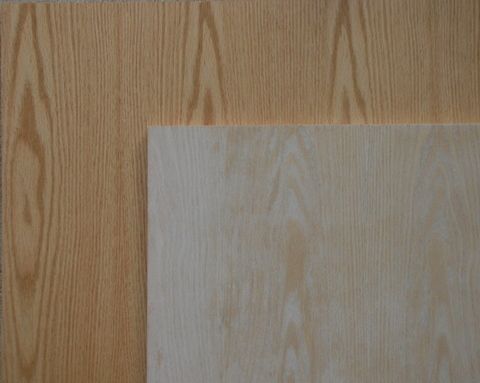Discoloration of Waterborne Finish on Imported Oak Plywood
A finisher finds that cheap imported plywood reacts badly with waterborne coatings. A barrier coat of shellac seems to prevent this, however. March 28, 2010
Question
I have a job where I am using an import red oak plywood. I have tried to finish the oak with Target EM6000, 9000 and 2000. I was intending on using the EM6000 for the interiors of the cabinets and the 9000 for the doors and exterior end panels. The image is the oak finished with three coats of Magnamax on the left sample and three coats of EM6000 on the right sample. I let the panel dry two hours between coats and used Mirka 320 to sand between coats. Shop temp is about 60-68 F with low humidity due to winter conditions. If I could take a closer picture you would notice that the EM6000 has a powdery feel. The problem does not occur on solid red oak or domestic. Any ideas?

Click here for higher quality, full size image
Forum Responses
(Finishing Forum)
From contributor A:
Perhaps Target doesn't like the smell of off-gassing formaldehyde. Another problem could be heavy metal contamination from the red mystery glue.
From contributor P:
That's bizarre. Another reason to swear off crappy import ply. I just finished an oak job using Target topcoats (on domestic oak ply) with no problem. Try shooting a barrier coat of dewaxed shellac before the topcoats.
From the original questioner:
Import ply or not, the question is about the finish rather than the source of the product. The product is made to be used, so there is a need to find a way to finish it. The Maganamax worked fine; the waterborne did not, and I want to know why.
From contributor P:
All kidding aside about the Chinese ply - the stuff is horrible. Won't stay flat, strange looking core, voids, bumps, the aforementioned red glue. You could ask the manufacturer, but good luck with that. I don't recall seeing any edge stamp on the product. Abandon it! Whatever money you save is spent trying to overcome its negatives.
Seriously, try the SealCoat, if only as a test. It will help determine if it's a contamination problem or some kind of weird chemical incompatibility.
From contributor M:
I have been using Target coatings for four years now and have had this happen a couple of times. Every time it happened it was on cheap 1/4" red birch with an MDF core. I wrote it off to the fact that the veneer was so thin that the coating didn't have enough to soak into. But the reasons mentioned above are equally as likely I guess. I would suggest starting out with a single wash coat of alcohol cut dewaxed shellac and then proceeding with the em6000. Also I would ditch the 9000 super clear for the em8000. It sprays nicer, dries faster, gives a more amber look like the 6000, the durability is outstanding, and last I checked it's cheaper too.
From the original questioner:
The seal coat of shellac corrected the problem but I am still curious as to why. I am going to test the ph of the top ply tomorrow. This ply seems to be quite a bit better than another lot of import birch I tried with the famous red glue. This one has yellow glue colour. I suspect the oak veneer was either treated with something or boiled in an odd solution before slicing. By the way, there is a $25 per sheet price difference versus domestic oak on particle core. That said, I regret my choice of material now. Haven't tried the EM8000 yet but I am interested to do so. I like the EM2000 very much.
From contributor R:
This might be a good lesson for when you bid your next job. Remember, the customer is the one who is paying for the materials, be it the lumber or the coatings. If they lowball you on price, you have no other option but to lowball your quality or refuse the job. If, on the other hand, you bid a job based on using the best of the best materials and you opt to use inferior materials, you end up eating the loss. So many times posters complain about the cost of something, you would think that they are paying for the materials themselves, but in reality, your customer is paying. Using inferior lumber is the same as using inferior coatings.
Go ahead and check the PH of the lumber and record the various temps in the shop and document these, but don't expect to put a $100.00 saddle on a horse destined for glue and expect it to look good. The plies of today are going to have a thinner surface veneer, whether they are an import ply or a domestic ply - that's the nature of the beast. Where they differ is in the quality of the core, the quality of the veneer itself and the quality of the glues used throughout the whole process. In my opinion, the domestic plies will be the best option for the type of projects you create.
Something else to consider when using a water based coating is that they contain a certain amount of ammonia built into their chemistry and this ammonia can have a reaction to the overall color of the wood, whether it's a clear coat for a natural finish or a clear coat over a stain.
From the original questioner:
Thanks. I agree, it was a good lesson learned and your logic is correct.
